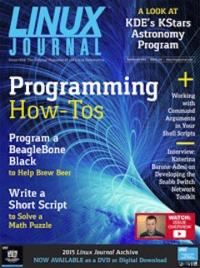February 2016 Issue of Linux Journal


For the Love of Linux
I love my job. I teach Linux by day and write about Linux at night. It's easy to fall in love with your work when the things you do align with your passions. All of us here in the Linux Journal community have a love for Linux and open source, but even inside our world, there are some topics that are just downright fun! This month is full of articles we're passionate about.
Joey Bernard starts off with a look at KStars. If you're a space nut like me, you'll want to check out his detailed look at the KDE-native astronomy program. It's dark enough to see the stars only at night, but with Joey's help, you can surf the night sky any time of day! Then, what better way to end a day of LCD star gazing than to read a tech book on your favorite subject? Reuven M. Lerner provides a breakdown of some of his top picks on topics from programming to podcasting. It's hard to go wrong with a good book, and Reuven will help you find one.
With the help of Dave Taylor, you will learn to deal with command arguments in
scripts using getopt in your code. Dealing with arguments doesn't seem
like a big deal, but what if people combine them? (For instance,
-rf instead of -r -f?)
Rather than write pages of conditionals, Dave explores how to use
getopt, which does all the dirty work for you. If you need to write a script
that accepts command-line arguments, this month's column is a must-read.
I take a step away from the keyboard this issue and head around to the back of the computer—specifically, to the power cord. My family recently moved into an old turn-of-the-century house, and even with a massive electrical overhaul, the power is flaky at best. I decided to share my experience this month and clarify some of the various hardware options available to help regulate and stabilize the electricity coming into your home or business. The fact that I'm writing this on a desktop computer rather than a laptop means my hard work has paid off!
Susan Sons has an incredible interview with Katerina Barone-Adesi this month where she gets the details on Snabb. If you've never heard of Snabb, you'll be glad you read the interview, because it's an incredible network toolkit that isn't built in to the Linux kernel. If the idea of bypassing the Linux kernel to increase speed seems odd, you definitely want to read this interview!
You might remember Kyle Rankin writing a few years ago about using a Pogo Linux device (and later a Raspberry Pi, I think) to keep his homebrew beer chilled while it aged. Klaus Kolle takes a different approach, and using a BeagleBone Black, he controls the heating of the mash during his beer-making process. Whether you need to keep your homebrew hot or cold, it turns out Linux can be the answer in either case! Check out his cool project this month, and potentially improve your beer while improving your geek cred.
Sol Lederman finishes off the issue with some awesome problem solving. The best use of Linux, or technology in general, is to make quick work of something that would take a long time to do on your own. Scripting was designed for that exact purpose. In this command-line tutorial, Sol describes how to write a one-liner to find a specific date, and then put that one-liner into a script to make it more flexible. Most good programs start with a problem that needs to be solved, and in this case, the problem is trying to find the next Friday the 13th.
We all have passions that drive us to learn and explore. For some of us (me!), it's feeding the birds. For others, it's brewing the perfect beer. The best part about being a Linux geek is that we can take advantage of Linux's open-source nature and make our passions really come to life. We hope you share some of the excitement we brought into this issue and can't wait to hear about what sorts of projects you improve with the help of our favorite OS!
Available to Subscribers: February 1










